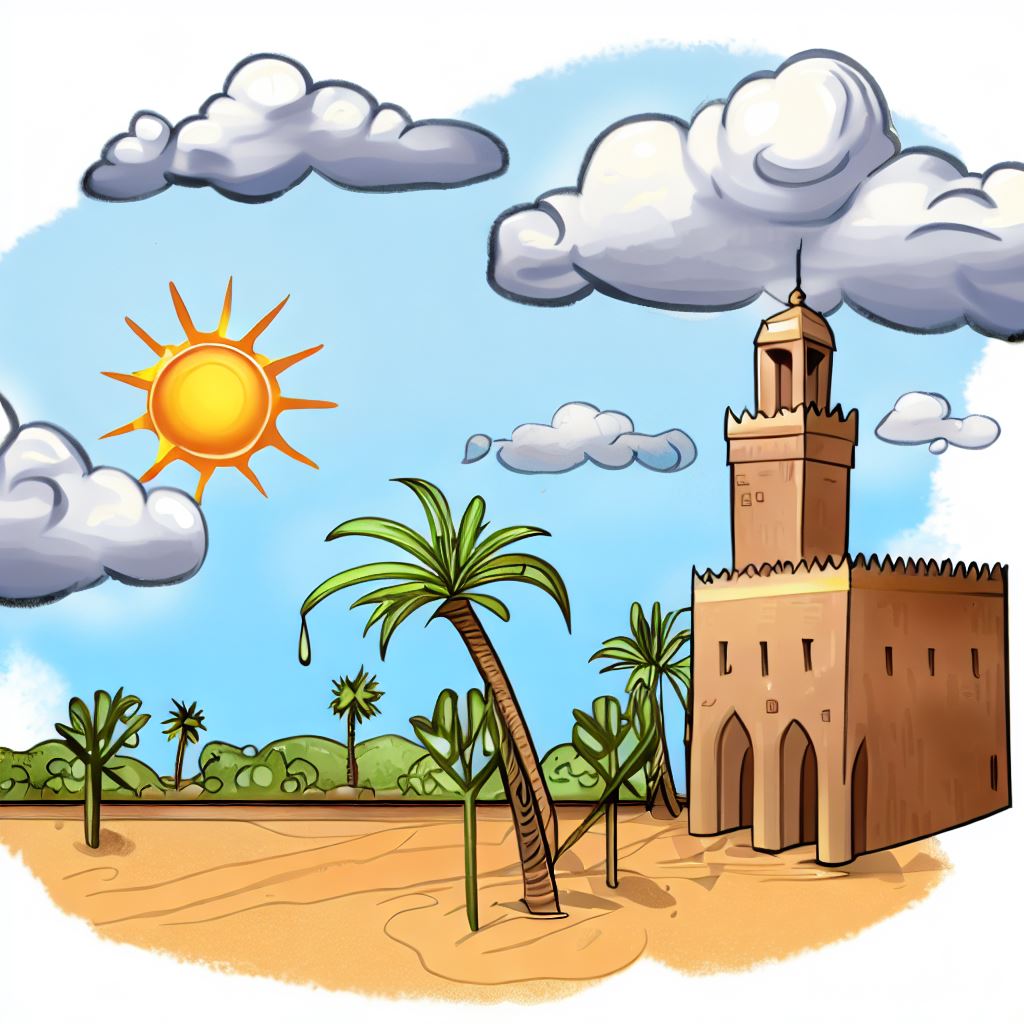
Month-by-Month Guide to Morocco's Weather
Morocco, a country of diverse landscapes, offers a unique climate that varies from one region to another. From the snow-capped Atlas Mountains to the sun-kissed beaches of Casablanca, the weather in Morocco is as varied as its landscapes. Whether you're planning a winter escape or a summer adventure, understanding the country's weather patterns is essential.
In this comprehensive guide, we'll delve deep into the month-by-month weather variations in Morocco, ensuring you're well-prepared for your trip.
Table of Contents:
- Introduction
- January
- February
- March
- April
- May
- June
- July
- August
- September
- October
- November
- December
- Common Misconceptions
- Key Takeaways
- Conclusion
- Related Articles
- Useful Links
January
January in Morocco is characterized by mild temperatures in the coastal regions and colder conditions in the interior and mountainous areas. In cities like Casablanca, you can expect temperatures ranging from 8°C to 17°C.
Pros:
- Fewer tourists, making it a peaceful time to explore.
- Ideal for those who prefer cooler climates.
Cons:
- Some attractions in the mountains may be inaccessible due to snow.
Casablanca in January
Casablanca, being a coastal city, enjoys milder temperatures compared to the interior. With an average temperature of 15°C, it's a pleasant time to explore the city's attractions.
February
February in Morocco sees a slight increase in temperatures, especially in the southern regions. Marrakech, for instance, experiences temperatures between 10°C to 20°C.
Pros:
- Almond blossoms in the Atlas Mountains are a sight to behold.
- Ideal for desert excursions.
Cons:
- Occasional rainfall can be expected.
Marrakech in February
Known as the 'Red City', Marrakech starts to warm up in February. With daytime temperatures reaching up to 20°C, it's a great time to explore the city's historic medinas and vibrant markets.
March
March marks the beginning of spring in Morocco. The temperatures continue to rise, and the landscapes transform with blooming flowers and greenery.
Pros:
- Perfect for outdoor activities like hiking and trekking.
- The Sahara desert offers comfortable temperatures for camping.
Cons:
- Spring winds can bring sandstorms in desert areas.
Fez in March
Fez, with its rich history and stunning architecture, is a delight in March. The weather is comfortable, allowing tourists to delve deep into its ancient alleyways and discover its hidden treasures.
Key Takeaways
- Coastal regions have milder temperatures year-round.
- The Atlas Mountains can be chilly during winter, with snowfall in higher altitudes.
- Southern regions, especially the Sahara, can get scorching during summer.
Common Misconceptions
- Morocco is hot year-round: While Morocco experiences warm temperatures, especially in the south, the coastal and mountainous regions can be quite cool, especially during winter.
- It never rains in Morocco: Contrary to popular belief, Morocco does receive rainfall, especially in the northern regions.
Conclusion
Morocco's diverse climate makes it a year-round destination. Whether you're looking to explore the bustling medinas, relax on the beaches, or trek the Atlas Mountains, there's always something to do. By understanding the country's weather patterns, you can plan your trip accordingly, ensuring a memorable experience.
From the chilly winters in the mountains to the warm summers on the coast, Morocco offers a unique blend of weather conditions that cater to every traveler's preference. So, pack accordingly and immerse yourself in the beauty and diversity of this North African gem.
Whether you're a history buff, a nature enthusiast, or a beach lover, Morocco's varied climate ensures there's something for everyone. So, when planning your next trip, consider the month-by-month weather guide to make the most of your Moroccan adventure.
Lastly, always keep an eye on the local weather forecasts, especially if you're planning to visit the mountains or the desert. This will ensure you're well-prepared for any sudden weather changes and can enjoy your trip to the fullest.
April
April is one of the most pleasant months in Morocco. The temperatures are moderate, and the country is awash with vibrant colors, thanks to the spring bloom.
Pros:
- Floral festivals in various cities.
- Great month for photography enthusiasts.
Cons:
- Some areas might still be cold during the nights.
Tangier in April
Tangier, located at the northern tip of Morocco, offers a Mediterranean climate. April sees a mix of sunny days and cool evenings, making it an ideal time for sightseeing and beach activities.
May
May marks the onset of summer. The days become longer, and temperatures start to rise, especially in the inland areas.
Pros:
- Perfect for beach holidays along the Atlantic coast.
- Outdoor festivals and events are in full swing.
Cons:
- Desert regions can start to become uncomfortably hot.
Rabat in May
The capital city, Rabat, experiences mild temperatures in May. With its historical sites and lush gardens, it's a perfect destination for those looking to combine culture with nature.
Related Articles:
A Comprehensive Guide to Weather in Agadir by Month
The Ultimate Agadir Guide: Discover the Jewel of Morocco
Affiliate Links:
Looking for transfer deals? Check out Get Transfer.
Discover the best things to do in Morocco with our activity guide.
June
June in Morocco is the official start of the summer season. The coastal areas remain cool and breezy, while the interior and southern regions begin to heat up.
Pros:
- Beach resorts start to buzz with activities.
- Evenings are longer, allowing for extended sightseeing.
Cons:
- Desert excursions can be challenging due to high temperatures.
Casablanca in June
Casablanca, being on the coast, offers a respite from the intense heat of the interiors. With temperatures ranging between 18°C to 26°C, it's an ideal time to enjoy the city's beaches and outdoor cafes.
July
July is one of the hottest months in Morocco. While the coastal areas remain relatively cool, temperatures in cities like Marrakech can soar above 35°C.
Pros:
- Perfect for enjoying Morocco's famed beach resorts.
- Nightlife and festivals are in full swing.
Cons:
- Midday heat can be intense, especially in the south.
Marrakech in July
Marrakech experiences its peak summer temperatures in July. However, the city's vibrant nightlife, with its rooftop bars and open-air festivals, ensures there's no shortage of evening activities to keep visitors entertained.
August
August continues the summer trend with high temperatures, especially in the inland areas. However, places like Essaouira on the coast offer a cooler climate, making them popular destinations during this month.
Pros:
- Coastal festivals and water sports are highlights.
- Mountain regions offer cooler temperatures for trekking.
Cons:
- Desert regions can be scorching and are best avoided during midday.
Essaouira in August
Essaouira, with its Atlantic breezes, is a haven for those looking to escape the summer heat. The city's annual Gnaoua Music Festival is a major draw, attracting visitors from all over the world.
Related Articles:
A Comprehensive Guide to Weather in Agadir by Month
The Ultimate Agadir Guide: Discover the Jewel of Morocco
Useful Links:
For the best flight deals, check out our Flight Deal Finder and Flight Plan Book.
Stay connected during your travels with an eSIM.
September
September marks the beginning of the fall season in Morocco. The temperatures start to drop, especially in the evenings, making it a pleasant time for travel.
Pros:
- Harvest season for various fruits, especially dates.
- Less crowded tourist spots.
Cons:
- Occasional rainfall can be expected in the northern regions.
Fez in September
Fez, with its ancient medinas and rich history, is particularly enchanting in September. The cooler temperatures make it ideal for exploring the city's narrow alleyways and historic sites.
October
October is one of the best months to visit Morocco. The weather is cool and comfortable, and the landscapes are painted in autumn hues.
Pros:
- Great for desert tours and camel treks.
- Outdoor festivals celebrate the harvest season.
Cons:
- Evenings can get chilly, especially in the mountainous regions.
Casablanca in October
Casablanca's coastal location ensures moderate temperatures in October. It's a perfect time to enjoy the city's beaches, promenades, and outdoor cafes.
November
November sees a further drop in temperatures. The mountain regions start to experience the first snowfalls, especially in higher altitudes.
Pros:
- Perfect for hiking in the Atlas Mountains.
- Off-peak travel rates and fewer tourists.
Cons:
- Shorter days mean less daylight for sightseeing.
Marrakech in November
Marrakech in November offers a mix of sunny days and cool evenings. The city's gardens and palaces are less crowded, allowing for a more intimate experience.
Related Articles:
A Comprehensive Guide to Weather in Agadir by Month
The Ultimate Agadir Guide: Discover the Jewel of Morocco
Affiliate Links:
Looking for car hire deals? Check out Discover Cars or Economy Bookings.
Discover the best activities in Morocco with our activity guide.
December
December in Morocco is characterized by chilly temperatures, especially in the evenings and early mornings. The festive season brings a unique charm to the cities, with local celebrations and events.
Pros:
- Festive atmosphere in major cities.
- Skiing opportunities in the Atlas Mountains.
Cons:
- Days are shorter, limiting daylight hours for activities.
- Desert regions can be particularly cold at night.
Tangier in December
Tangier, with its Mediterranean climate, experiences mild winters. December is a time of festivities, and the city is adorned with lights and decorations, making it a magical time for visitors.
Common Misconceptions:
Many believe that Morocco is warm year-round due to its location in North Africa. However, the country experiences a range of climates from Mediterranean to desert, leading to significant temperature variations.
Key Takeaways:
- Morocco offers diverse climates, catering to a variety of travel preferences throughout the year.
- Coastal regions remain relatively mild even in peak summer, while the interiors can get quite hot.
- Winter months offer skiing opportunities in the mountains and pleasant temperatures in the cities.
Conclusion:
Morocco, with its rich cultural heritage and diverse landscapes, is a destination for all seasons. Whether you're looking to bask in the summer sun, explore historic medinas, or enjoy winter sports in the mountains, Morocco has something to offer for every traveller. This comprehensive month-by-month guide aims to provide insights into the country's weather patterns, helping you plan your trip accordingly. So, pack your bags and get ready for an unforgettable Moroccan adventure!
Related Articles:
A Comprehensive Guide to Weather in Agadir by Month
The Ultimate Agadir Guide: Discover the Jewel of Morocco
Affiliate Links:
For the best flight deals, check out our Flight Deal Finder and Flight Plan Book.
Stay connected during your travels with an eSIM.



